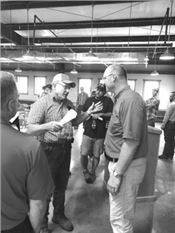|
Hundreds Of Local Cattle Producers Attended Drought Survival Meetings

Tim Schnakenberg (left) visiting with the crowd.
SPRINGFIELD, MO.
A summer rain did not keep cattle producers away from drought survival workshops conducted by University of Missouri Extension on Aug. 17 at the Southwest Research Center in Mt. Vernon and at the Springfield Livestock Marketing Center near Republic.
The meeting at the livestock marketing center had over 150 in attendance. The workshop in Mt. Vernon attracted 102 cattle producers.
Dr. Eric Bailey, state beef nutrition specialist at the University of Missouri, began the workshop by saying he believes planning for drought is not going to be something that needs the attention of cattle producers in just 2018.
“What we have is drought intensifying and I do think we have some real challenges ahead of us in the next 60 days and perhaps beyond,” said Bailey. “Feeding your way through the drought is going to be key and that means the cows simply need more calories.”
During drought, convenience is a factor that does not work in our favor according to Bailey.
“It is going to take more labor and more strategy during a dry period,” said Bailey. “Giving them access to hay during limited periods of time is one strategy to help stretch the hay.”
Calculating prices on feed and the needs of the cattle is essential according to Bailey. In fact, $200 a ton feed makes more sense financially than the current costs of baled hay, in most cases.
“We do over complicate things and we wait just one more day hoping on the rain,” said Bailey. “That is not a good strategy. Do something to save the body condition score of your cattle. Doing something is better than doing nothing.”
Summer drought has caused headaches for livestock producers who are preparing to feed cattle this winter with little forage or hay on hand. This workshop focused on supplementing low-quality hay, alternative feeds, herd culling, precautions with nitrates and prussic acid, fall forage alternatives and assessing the price of forages.
“The drought has taken a major toll on beef and dairy farms in the area. Short hay supplies will continue to plague these farms as we go into winter,” said Tim Schnakenberg, agronomy specialist with MU Extension. “Producers need to take extra steps to stretch their feed supplies and know what alternatives are available to address the crisis.”
This drought might also provide the best opportunity to cull your herd according to Elon Cole, livestock specialist with MU Extension.
“It may be a good idea to cull any cow that is open, old, ornery or has problems like bad teeth or bad udders or eye problems,” said Cole.
One unusual step is wean calves off early.
“You can actually wean a calf off at three to four months. It is cheaper to feed the calf than to feed the cow so she can keep the calf alive,” said Cole.
Cattle producers in attendance at the workshop had high praise for the information.
“This was the best organized comprehensive impromptu meeting I’ve seen,” said Mary Turton of Springfield. “Great information from speakers with years and years of experience. The stress of the challenge is wearing on the toughest of us.”
Marsha Moreland of Aurora attended the program at the Southwest Center.
“Great info and comments from the crowd. I hope all attendees test their hay. Your doctor doesn't prescribe any medications until a blood test is drawn. A hay test or soil test is like the blood test,” said Moreland.
Schnakenberg and Bailey and Cole all spoke at the event along with Jill Scheidt, agronomy specialist and Jim Spencer, agriculture business specialist.
A number of producers also brought lower stems of fertilized sudangrass, millet, Johnsongrass and bermudagrass for a quick subjective analysis of nitrates by MU Extension agronomy specialists.
The Lawrence and Greene County MU Extension Councils organized these meetings for cattle producers who want tips for surviving the drought. ∆
|
|